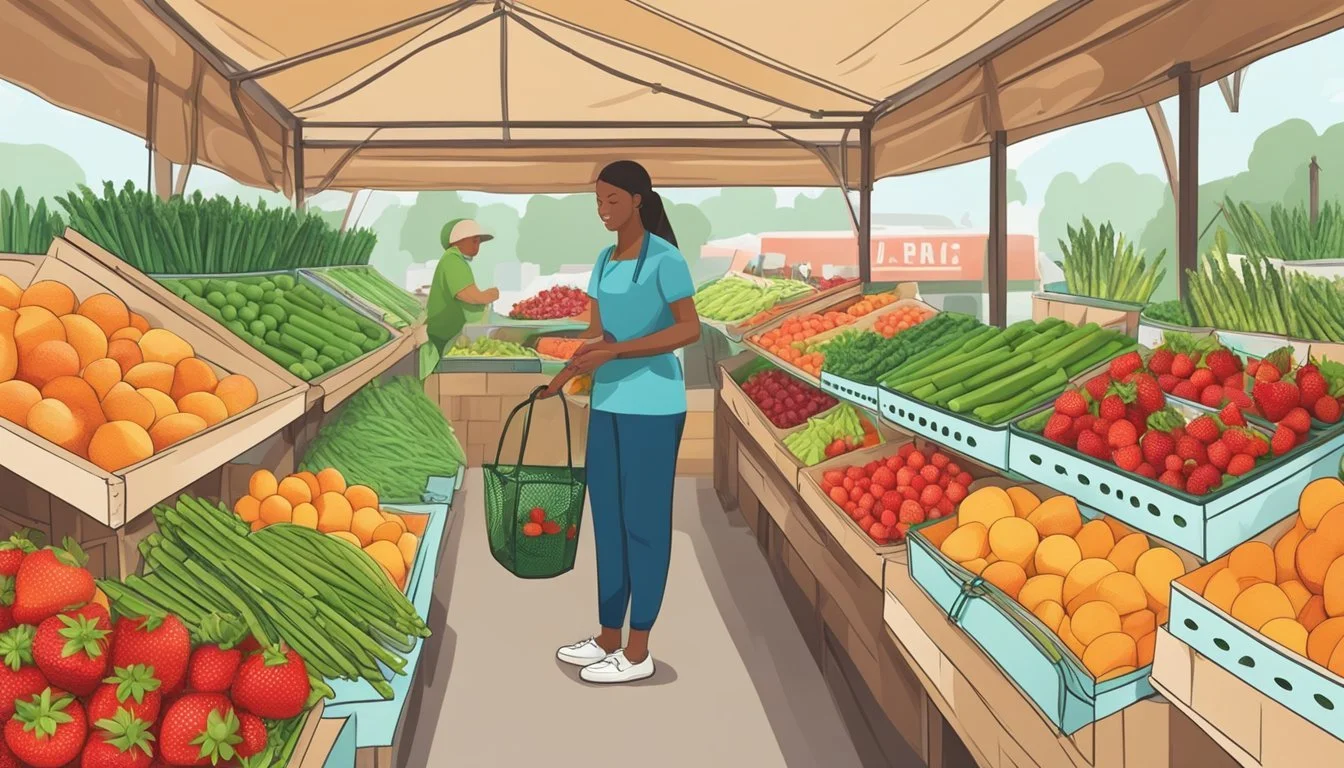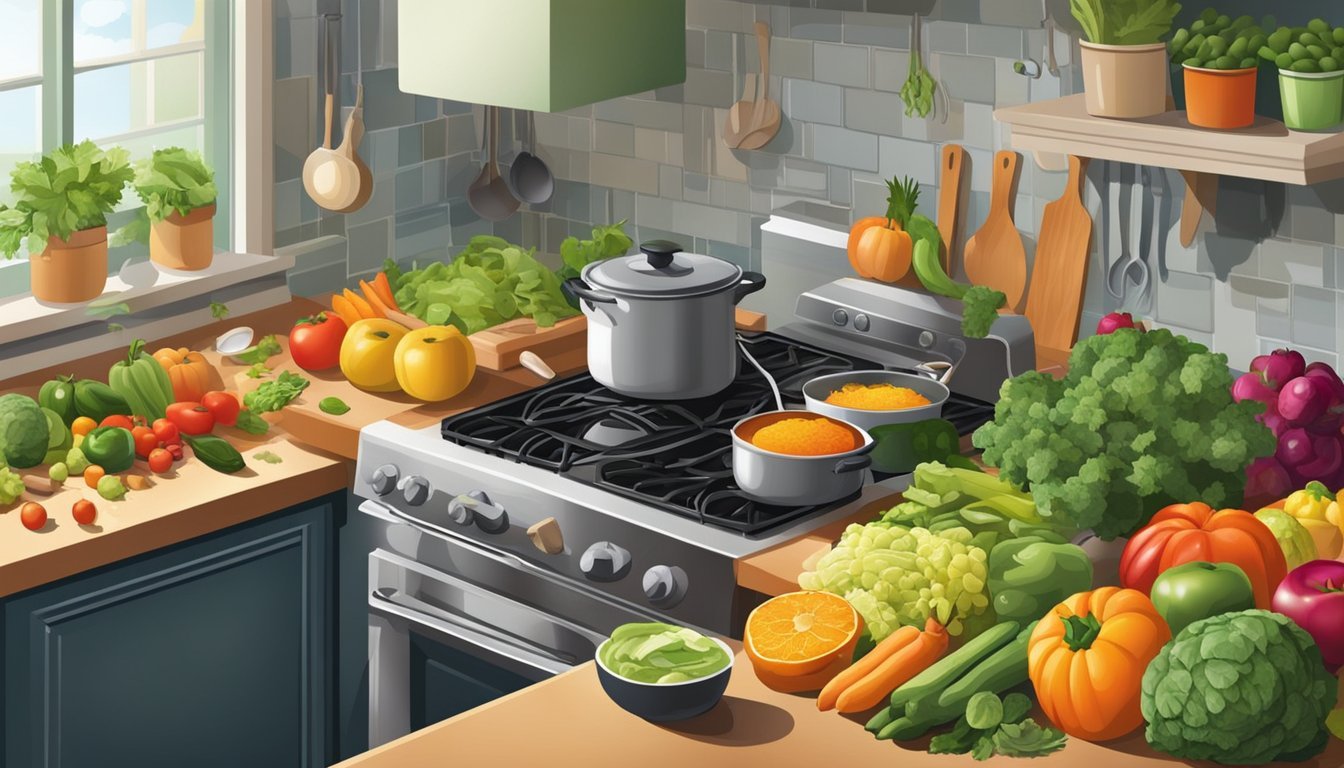New York Seasonal Fruit & Vegetables in June
A Fresh Guide to Local Produce
This Article is Part of our New York Seasonal Fruit & Veg Calendar
In New York, June marks a vibrant transition in the local food scene as a variety of seasonal fruits and vegetables reach their peak. With longer days and warmer weather, the soil yields an abundance of fresh produce. Eating local during this month not only supports the regional agriculture but assures consumers are getting the freshest and most flavorful produce.
Local markets and farm stands start to teem with fresh greens, berries, and a host of vegetables. Among the seasonal offerings, one can find crisp lettuces, sweet strawberries, and juicy cherries (how long do cherries last?). These fruits and vegetables not only represent the height of June's harvest but also embody New York's agricultural diversity.
Vegetables such as radishes, cucumbers (how long do cucumbers last?), and peas are also at their best in June. These crops benefit from the milder early summer temperatures, which help them develop their full flavors. This time of year is perfect for consumers to explore the variety of local produce available in New York and to enjoy the health and taste benefits that come with eating seasonally.
Seasonal Fruits and Vegetables Overview
June marks the abundance of fresh produce in New York as various fruits and vegetables reach their peak harvest time. Consumers can enjoy a wide range of options due to the increased availability during this month.
Fruit Harvest in June
In New York, June is a transitional month for fruit harvests. It's the time when the last of the spring fruits and the beginning of summer fruits become ready for picking.
Strawberries: Typically peaking in June, they are one of the first summer fruits to become available.
Cherries: Sweet cherries start to come into season, offering their juicy and vibrant flavors to consumers.
Blueberries: (how long do blueberries last?) Toward the end of the month, blueberries begin their season, hinting at the berry abundance that July will bring.
Summer Vegetables Availability
Vegetable gardens and markets in New York brim with a variety of vegetables in June, ranging from leafy greens to the first of the summer's heartier vegetables.
Leafy Greens: Lettuces, spinach (What wine goes well with spinach?), and kale remain in good supply, with the warmer weather enhancing their growth.
Peas: Sugar snap peas and snow peas are at their best, ready to be enjoyed fresh or lightly cooked.
Beets: Beetroots thrive in June, offering both their earthy roots and nutritious greens.
Zucchini (What wine goes well with zucchini?): Early summer squash varieties like zucchini become increasingly available as the month progresses.
Broccoli: Broccoli continues to be harvested, providing a wealth of nutrients and flavor.
The list above is not exhaustive but represents a significant part of the produce you can expect to find in New York during the month of June.
June Specific Produce
In June, New York bursts with a variety of fresh produce. Market stalls and local farms offer an abundance of fruits and vegetables that are ripe for the picking.
List of June Fruits
Strawberries: These berries reach their peak sweetness in June, making it an ideal time for harvest.
Blueberries: Another berry that enters its prime is the blueberry, offering a mix of tangy and sweet flavors.
Cherries: Sweet and sour cherries are both available, providing a juicy treat.
Peaches: Juicy peaches also start to make their appearance, perfect for pies or enjoyed fresh.
List of June Vegetables
Asparagus (how long does asparagus last?): Early June often marks the end of the asparagus season, so it's a last chance to enjoy fresh spears.
Beets: Known for their earthy flavor, beets are in abundance during June and can be enjoyed raw or cooked.
Carrots (how long do carrots last?): Sweet, crunchy carrots are also part of the June harvest.
Corn: Sweet summer corn starts becoming available by the end of the month.
Cucumber: Crisp cucumbers are perfect for refreshing salads.
Lettuce & Kale: Both lettuce and kale are common in June, ideal for green salads.
Greens: A variety of greens, including spinach and Swiss chard, are typically plentiful.
Farming in New York
New York State's diverse agriculture is sustained through a variety of local farms, with harvest times influenced greatly by the regional climate. Understanding the local farming landscape and climate patterns is essential for appreciating the state's produce offerings.
Local Farms and Harvest Times
New York State is home to a myriad of local farms ranging from small-scale family operations to larger agricultural enterprises. The growing season in New York varies across the state, with local farms typically beginning their harvest in late spring and continuing into late fall. June marks the time when these farms start offering a vibrant array of fresh produce, with harvest times peaking for several key fruits and vegetables.
Fruits: Strawberries, cherries
Vegetables: Lettuce, kale, peas, radishes, beets
Each farm's harvest time can vary based on its specific location within the state and the microclimates present.
Impact of New York's Climate on Produce
The climate in New York State plays a crucial role in defining the harvest times and quality of produce available. New York's climate can be characterized by cold winters and moderate summers, which affects the growth and seasonality of fruits and vegetables.
Fruits: The state’s cool spring helps in the gradual ripening of fruits, ensuring a burst in flavor by June.
Vegetables: Warmer temperatures towards the end of spring stimulate the growth of a variety of vegetables, making them ready for harvest in early summer.
It's important to recognize how the unique climate contributes to the distinct taste and quality of produce from New York's local farms.
Buying and Storing Tips
In New York, June brings an array of fresh fruits and vegetables to the table. Knowing where to purchase and how to store these seasonal items ensures both optimal flavor and longevity.
Where to Buy Fresh Produce
Farmers markets are a go-to destination for the freshest seasonal produce. Shoppers can find a myriad of fruits and vegetables, with the added benefit of supporting local agriculture. Below is a table highlighting popular markets in New York:
Market Name Location Notable Produce Union Square Greenmarket Manhattan, New York Strawberries, Cherries, Greens Brooklyn Borough Hall Brooklyn, New York Beets, Carrots, Green Beans
For fresh fruit like strawberries and cherries, one should seek vendors that offer samples or inspect the produce for firmness and color. In contrast, when selecting vegetables such as greens, beets, and carrots, one should look for vibrant colors and crisp textures.
Storage Recommendations
Proper storage is critical for maintaining freshness and extending the life of produce. Here's a guide for some of the common items found in June:
Leafy Greens: Store in the refrigerator, loosely wrapped in a damp paper towel and housed in a breathable bag to maintain moisture.
Berries: Keep in a single layer container in the refrigerator to minimize bruising, and only wash them right before consumption to prevent mold.
Root Vegetables (Carrots, Beets): Remove any tops to prevent moisture loss, store in the refrigerator crisper drawer in a loose plastic bag.
Onions and garlic require a cool, dark place and should not be refrigerated. They are best kept in a well-ventilated area, separated from potatoes to prevent mutual deterioration. Summer squash and zucchini, harvested later in June, benefit from refrigeration, ideally stored in a plastic bag punched with holes for circulation.
Note that these storage tips are crucial during the summer months when temperatures and humidity can cause hastened spoilage.
Health and Nutrition
Eating seasonally and locally in New York during June offers a bounty of health and nutritional advantages. Fresh fruits and vegetables harvested at their peak are not only at their most flavorful but also often contain optimal levels of vitamins and minerals.
Nutritional Benefits of Seasonal Eating
Seasonal fruits and vegetables in June have had ample sunlight and time to grow naturally, resulting in produce rich in antioxidants, fiber, and essential nutrients. Here are some specific benefits and nutrient-dense choices available during this month:
Strawberries: A rich source of vitamin C, manganese, folate, and potassium.
Blueberries: High in antioxidants, vitamins C and K, and dietary fiber.
Cherries: Contain vitamins C and A, antioxidants, and melatonin, which can aid sleep.
Leafy Greens (such as spinach and kale): Excellent sources of vitamins A, C, K, iron, and calcium.
Radishes: Provide vitamin C, potassium, and fiber, while being very low in calories.
Peas: Offer vitamins C and K, manganese, and dietary fiber.
Eating local in New York not only supports the regional economy but also contributes to better health outcomes. Local produce is typically fresher, having spent less time in transit, which means it can retain more of its nutritional value. Additionally, consuming a diverse array of plant-based foods is linked to a reduced risk of many chronic diseases, including heart disease and type 2 diabetes. By choosing foods that are in season, individuals are likely to enjoy a richer, more varied diet that contributes to their overall well-being.
Cooking and Preparation
In June, New York's bounty of seasonal fruits and vegetables invites a wealth of cooking opportunities and preservation techniques to extend their enjoyment. Embracing these methods ensures flavors are maximized and the harvest is savored throughout the year.
Seasonal Recipes
New York in June provides a plethora of ingredients leading to a vibrant assortment of recipes. Sweet cherries can be pitted and baked into clafoutis or pies, while strawberries lend their sweetness to jams or fresh salads. Blueberries are perfect for morning pancakes or as a topping for yogurt. Savory dishes benefit from vegetables like beets, which can be roasted for salads or blended into a vibrant soup.
Strawberry Spinach Salad
Fresh strawberries, sliced
Baby spinach
Goat cheese crumbles
Slivered almonds
Balsamic vinaigrette
Chilled Beet Soup
Roasted beets, pureed
Chicken or vegetable stock
Sour cream or Greek yogurt
Dill, chopped
Salt and pepper to taste
Preservation Techniques
Preservation allows these seasonal delights to be enjoyed beyond their natural harvest window. Strawberries and blueberries can be frozen on a baking sheet before being transferred to airtight containers to maintain their shape and flavor for future use. Beets can be pickled with vinegar, water, and spices, creating a condiment with a lengthy shelf life. Cherries can be canned with sugar syrup or dehydrated for a chewy, sweet snack.
Beets, boiled and peeled
Vinegar
Sugar
Pickling spices (how long does pickling spice last?)
Jars with lids, sterilized
Freezing Berries
Fresh berries, washed and dried
Baking sheet lined with parchment paper
Airtight containers or freezer bags
Seasonal Calendars and Guides
Seasonal calendars are quintessential for determining the availability of fresh produce in New York. They guide consumers and businesses in planning their purchases and menus around locally harvested fruits and vegetables.
Monthly Availability Calendar
June in New York brings a diverse range of seasonal produce, aligning with the transition from spring to summer. A detailed monthly availability calendar can assist in identifying what is freshly picked during this time. These calendars typically note the peak harvesting periods for various produce, aiding in the selection of the freshest ingredients for culinary use or direct consumption. Below is a representation of typical produce available in June:
Fruits Vegetables Strawberries Lettuce Cherries Radishes Raspberries Zucchini Blueberries Summer Squash Cucumbers Green Beans Peas
This selection changes as July approaches, marking the height of summer, with additional fruits and vegetables like corn and tomatoes reaching their peak availability.
Planning for Upcoming Months
Calendars provide foresight into upcoming months, such as July and beyond, advising stakeholders in the fresh produce supply chain on how to prepare for the transition of seasons. For instance, one can anticipate the end of the spring harvest and the beginning of the full summer variety, which not only informs immediate purchasing decisions but also enables planning for fall. Here's a brief look at what to expect:
Coming into July:
Fruits: Peaches, Watermelons, and Plums begin their season.
Vegetables: Carrots and Cauliflower start becoming available.
Looking ahead towards fall:
Consumers and businesses can start planning for the autumn harvest in advance, where apples and pumpkins become prominent. Being informed through these calendars allows for efficient and effective seasonal planning.






